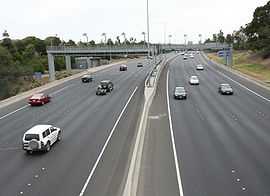e-TAG

e-TAG is an electronic toll collection system used on all tollways throughout Australia. The system was originally developed by Transurban for use on their CityLink tollway in the early 1990s, with the system since adopted by all toll roads, bridges and tunnels in Australia. The technology has different names depending on the issuer - such as Breeze (Eastlink Melbourne),[1] go via (Queensland),[2] E-toll (Roads & Traffic Authority (NSW))[3] and E-way (Sydney motorways M5 and M1),[4] however these are all interchangeable across Australia and no surcharges apply for use on other operators' toll roads.[5]
Toll roads in Australia use free-flow tolling, with no toll booths along the entire length of the system to impede traffic flow. Australia was one of the first countries in the world to have complete, surcharge-free interoperability between rival tolling providers across different state roadway systems. In 2006, the New South Wales Government announced that all cash tolls on the Sydney Orbital Network will cease by 2010.[6] In July 2007, both e-TAG and e-pass video tolling arrangements were introduced in the Sydney Harbour Tunnel, Westlink M7, Cross City Tunnel and the Lane Cove Tunnel.[7] This measure substantially eased traffic jams heading towards electronic gantries, providing increased convenience and time savings. In early 2009, the Sydney Harbour Bridge became toll-booth free, requiring e-TAGs to be used.
There are over 850,000 e-TAG account customers, and over 1 million e-TAGs have been issued.[8]
Technology
The e-TAG electronic tolling is based on radio-frequency identification (RFID) transponders using the DSRC protocol. The system uses electronic transponders (called e-TAGs) mounted on the inside of the vehicles' windscreen. Gantries constructed over each carriageway record registration plates and detect the e-TAGs. As the vehicle continues along the toll road, additional gantries monitor the distance travelled. Associated software then determines the toll amount payable, which is automatically deducted from the prepaid account associated with the tag.
Where a tag is not detected, the vehicle's registration is recorded using video tolling technology which incorporates an automatic number plate recognition system and checked against a government motor registration database. For infrequent use of the system a user can buy a Daypass – by phone, online, at any Australia Post outlet or at participating service stations. A Daypass can be bought in advance or afterwards (until midnight three days later). If payment has not been made after three days, the vehicle's registered owner will be sent a late toll invoice in the mail, and if the late toll invoice is then not paid a fine will be issued.
In 2003 it was found that e-TAGs did not warn drivers when their batteries were running low, and non-functioning batteries caused vehicles not to be detected by the toll sensors, thereby attracting additional charges and fines.[9] It has since been recognised that e-TAGs have a limited lifespan and a campaign was undertaken to raise awareness among customers to contact the issuer should an e-TAG not beep.[10] The issuer would then send a replacement e-TAG.
See also
References
- ↑ "How to Pay". EastLink. Retrieved 21 March 2015.
- ↑ "go viatag". go via. Retrieved 21 March 2015.
- ↑ "myE-Toll". Myrta.com. 27 June 2003. Retrieved 21 March 2015.
- ↑ "Pay Sydney toll roads with an E-way toll tag". Tollpay.com.au. Retrieved 21 March 2015.
- ↑ "Welcome to Sydney Motorways". Sydneymotorways.com. 11 March 2013. Retrieved 21 March 2015.
- ↑ Aston, Heath (25 April 2007). "Sydney toll network dumps coins". The Daily Telegraph (Australia). Retrieved 3 August 2011.
- ↑ Aston, Heath (5 July 2007). "Drivers' gridlock on e-tags". The Daily Telegraph (Australia). Retrieved 3 August 2011.
- ↑ "There are many ways to ROAM" (PDF). roam.com.au. Retrieved 21 March 2015.
- ↑ Hopkins, Philip (21 August 2003). "The Age – 'e-TAG woes take toll on Transurban shares'". Melbourne. Retrieved 12 August 2007.
- ↑ "CityLink – Using your e-TAG device". Archived from the original on 29 August 2007. Retrieved 12 August 2007.
Official site
- Roam Tolling Pty Ltd
- Transurban Group (Parent Company)